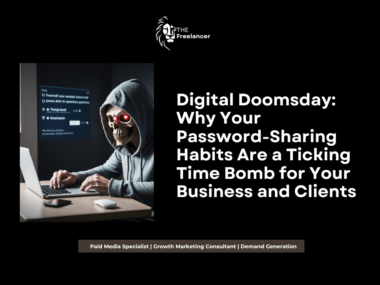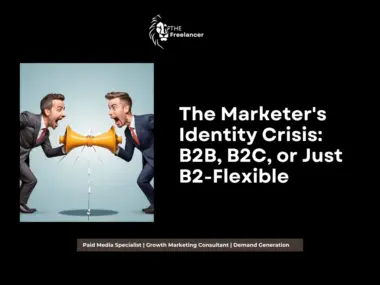Picture this: You’ve just spent a small fortune on a shiny new website for your small business. It’s got all the bells and whistles – a sleek design, your company’s entire life story, and even a blog that you swore you’d update weekly (spoiler alert: you won’t). You sit back, crack open a celebratory beverage, and wait for the flood of customers to come pouring in.
Crickets.
Welcome to the harsh reality of the digital age, where having a website is about as groundbreaking as owning a pair of socks. “But wait,” you cry, clutching your pearls, “I thought a website was essential for any business!” Well, my friend, it’s time to challenge that notion and explore the brave new world of digital presence for small and medium-sized businesses (SMBs).
In this deep dive, we’ll explore the value (or lack thereof) of websites for non-ecommerce SMBs, ponder the future of digital presence, and maybe, just maybe, figure out where you should be throwing your hard-earned marketing dollars. Buckle up, because we’re about to take a wild ride through the digital landscape of tomorrow!
Part 1: The Great Website Debate
Let’s start by addressing the elephant in the room: Do SMBs really need a website if they’re not selling products online? It’s a question that would have been considered blasphemous just a few years ago, but in today’s rapidly evolving digital ecosystem, it’s a valid concern.
The Traditional Argument for Websites:
For years, we’ve been told that a website is the digital equivalent of a storefront. It’s where potential customers go to learn about your business, check your credentials, and decide whether they want to engage with you. The arguments in favour of having a website typically include:
1. Credibility: A professional website lends legitimacy to your business.
2. Information Hub: It’s a central location for all your business information.
3. 24/7 Availability: Your website works even when you’re sleeping.
4. Control: You own the platform and the message.
These are all valid points, and they’ve served businesses well for the past couple of decades. But let’s be real – the internet has changed, and so have consumer behaviours.
The Case Against Websites for Non-Ecommerce SMBs:
1. Low Traffic: If you’re not actively driving traffic through SEO or paid advertising, your website is essentially a digital ghost town.
2. Maintenance Costs: Keeping a website updated and secure can be a significant ongoing expense.
3. Changing User Behaviour: People are spending more time on social media and other platforms than browsing individual websites.
4. Mobile-First World: Many users prefer app-based experiences over traditional websites.
The Reality Check:
Let’s face it – unless you’re investing heavily in driving traffic to your website, it’s likely that no one is coming to visit. It’s like throwing a party and forgetting to send out invitations. Sure, your website might look great, but if it’s not generating leads or conversions, is it really worth the investment?
For many SMBs, especially those operating in local markets or service-based industries, a website might be overkill. If your primary goal is to provide basic information and contact details, there are often more effective and less expensive ways to achieve this.
Part 2: The Evolving Digital Landscape
To understand where we’re headed, let’s take a quick look at how digital presence has evolved:
1990s: “You’ve got a website? Wow, you’re on the cutting edge!”
2000s: “No website? Does your business even exist?”
2010s: “Your website isn’t mobile-responsive? How quaint.”
2020s: “Wait, you’re still relying on just a website?”
As we move further into the 2020s and beyond, the concept of a standalone website is becoming increasingly outdated. Instead, businesses are finding success by diversifying their digital presence across multiple platforms and channels.
The Rise of Platform-Based Presence:
Rather than investing in a single website, many SMBs are finding success by leveraging existing platforms:
1. Social Media Profiles: Platforms like Facebook, Instagram, and LinkedIn offer robust business profiles that can serve many of the same functions as a traditional website.
2. Google My Business: For local businesses, a well-optimised Google My Business profile can be more effective than a website in driving foot traffic and phone calls.
3. Industry-Specific Platforms: Depending on your niche, platforms like Yelp, TripAdvisor, or Houzz might be more relevant to your target audience than a standalone website.
4. Messaging Apps: With the rise of conversational commerce, platforms like WhatsApp and Facebook Messenger are becoming increasingly important for business communications.
The Advantage of Platform-Based Presence:
1. Built-in Audience: These platforms already have millions of users actively searching for businesses like yours.
2. Lower Costs: Maintaining profiles on existing platforms is generally less expensive than building and maintaining a website.
3. Easier Updates: Most platforms offer simple interfaces for updating information and posting content.
4. Mobile-Optimised: These platforms are already optimized for mobile users, which is crucial in today’s smartphone-dominated world.
Part 3: The Future of Digital Presence
Now, let’s put on our futurist hats and imagine what digital presence might look like in the coming years. Remember, we’re thinking outside the box here, so some of these ideas might seem a bit far-fetched. But then again, so did the internet itself not too long ago.
1. Augmented Reality (AR) Business Cards:
Imagine a world where instead of handing someone a paper business card or directing them to a website, you give them an AR-enabled digital card. When scanned with a smartphone or AR glasses, it comes to life, displaying a 3D model of your products, a virtual tour of your office, or even a holographic version of yourself giving your elevator pitch.
2. AI-Powered Digital Assistants:
Rather than a static website, businesses might have AI-powered digital assistants that can engage in natural language conversations with potential customers. These assistants could answer questions, schedule appointments, and even negotiate deals, all while learning and improving from each interaction.
3. Blockchain-Based Decentralised Profiles:
As concerns about data privacy and ownership grow, we might see a shift towards decentralised digital profiles. Businesses could maintain a single, verifiable digital identity across multiple platforms, with full control over their data and how it’s shared.
4. Virtual Reality (VR) Showrooms:
For businesses that rely on showcasing products or services, VR showrooms could replace traditional websites. Customers could don a VR headset and explore a fully immersive representation of your business, interacting with products and services in a way that’s impossible with a 2D website.
5. Neural Interface Business Profiles:
Looking even further into the future, as brain-computer interfaces become more advanced, we might see business profiles that can be accessed and interacted with directly through thought. Imagine being able to instantly call up information about a business or product simply by thinking about it.
6. Holographic Storefronts:
As holographic technology improves, businesses might project digital storefronts into public spaces. Passersby could interact with these holograms to learn about products, services, and even make purchases, blending the physical and digital worlds.
7. Quantum-Entangled Business Networks:
In a world of quantum computing, businesses might maintain quantum-entangled networks that allow for instantaneous, unhackable communication and data sharing across vast distances. Your business presence could exist in a state of quantum superposition, simultaneously everywhere and nowhere.
Part 4: Where to Invest Your “Website” Money Today
While some of these futuristic ideas might still be a way off, there are plenty of innovative ways SMBs can invest in their digital presence today that go beyond the traditional website model:
1. Chatbots and Conversational AI:
Invest in developing intelligent chatbots that can handle customer inquiries across multiple platforms. This can provide 24/7 customer service without the need for a full website.
2. Video Content Creation:
With the rise of platforms like TikTok and YouTube Shorts, short-form video content is becoming increasingly important. Invest in creating engaging video content that showcases your products or services.
3. Podcast Production:
For businesses that rely on expertise and thought leadership, starting a podcast can be an effective way to reach your audience and establish authority in your field.
4. Interactive Social Media Experiences:
Invest in creating interactive social media experiences, such as Instagram filters, Facebook quizzes, or LinkedIn polls that engage your audience and increase brand awareness.
5. Virtual Events and Webinars:
With the rise of remote work and digital networking, virtual events and webinars can be an effective way to connect with your audience and showcase your expertise.
6. Mobile App Development:
For businesses that interact frequently with customers, a custom mobile app might be more useful than a website. This could include features like appointment booking, loyalty programs, or exclusive content.
7. Voice Search Optimisation:
As voice-activated devices become more prevalent, optimizing your digital presence for voice search can help you stay ahead of the curve.
8. Influencer Partnerships:
Collaborating with influencers in your niche can help you reach a wider audience without the need for a traditional website.
9. Digital Business Card Platforms:
Invest in digital business card platforms that allow you to create an interactive, shareable digital presence that’s more dynamic than a traditional website.
10. Augmented Reality Experiences:
Start experimenting with AR experiences that allow customers to interact with your products or services in new and exciting ways.
Conclusion: The Death of the Website (As We Know It)
As we’ve explored in this deep dive, the future of digital presence for SMBs is likely to be far more diverse and dynamic than the traditional website model we’ve grown accustomed to. While websites aren’t going to disappear overnight, their role is changing, and businesses that adapt to new forms of digital presence will have a significant advantage.
The key takeaway is this: Don’t invest in a website just because you think you should. Instead, think critically about where your audience spends their time online and how you can best reach and engage them. The future of digital presence is about meeting your customers where they are, not expecting them to come to you.
Remember, in the fast-paced world of digital marketing, today’s cutting-edge technology is tomorrow’s outdated relic. (Just ask MySpace Tom – he’s probably still waiting for someone to accept his friend request.) So stay flexible, keep experimenting, and don’t be afraid to try new things.
Who knows? In a few years, we might all be beaming our business profiles directly into each other’s brains. Until then, may your digital presence be strong, your customers engaged, and your website… well, maybe you don’t need one after all.










